
JunOS_2_routingessentials
.pdf
JUNOS Routing Essentials
Behavior Aggregates (contd.)
Once a packet is marked with a BA, you can have downstream devices read those markers and automatically assign packets the correct forwarding class and loss priority. To initiate this process, you apply a BA classifier to the inbound interface. You apply BA classifiers to interfaces under the [edit class-of-service interfaces] hierarchy. For example, to apply the default IP precedence BA classifier, type set interface-name unit logical-unit-number classifiers inet-precedence default. You can apply BA classifiers at both Layer 2 and Layer 3; however, many platform-specific limitations govern the valid combinations of classifiers. See the JUNOS Class of Service Configuration Guide for detailed information.
Using the default BA classifiers and rewrite rules ensures that traffic from Queues
Reproduction |
||
0–3 maps correctly to the corresponding forwarding classes throughout the network. |
||
You must use a custom classifier and rewrit rule if you wa |
t to consistently map |
|
traffic across the network to more than Queues 0–3 |
r if y |
u wa t to use nondefault |
bit patterns for the CoS header fields. If you apply cus |
m classifiers and rewrite rules, |
|
you must apply these rules to all devices within he ne w rk to ensure consistent classification.
Not |
for |
|
Class of Service • Chapter 4–15
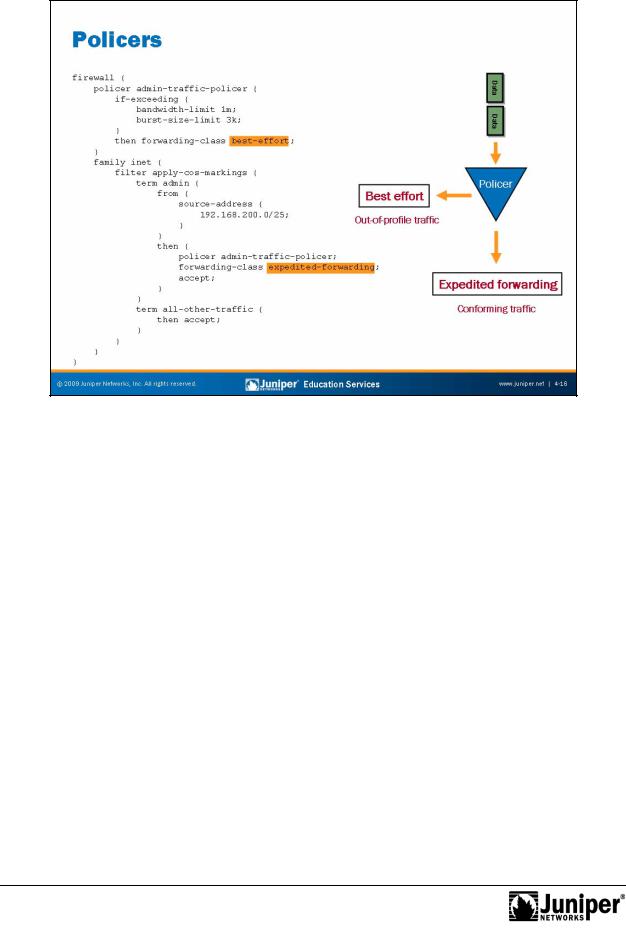
JUNOS Routing Essentials
Policers Reproduction
Policers allow you to limit certain kinds of traffic to a specified bandwidth and burst size. Youforcan configu e JUNOS devices to assign a different forwarding class or loss priority to traffic exceeding the configured limits. You can configure these policers like a regular traffic p lice , using the forwarding-class and loss-priority statements in the then clause of the policer. The forwarding-class and loss-pri rity statements from the policer override any forwarding-class
Notand loss-priority statements in the firewall filter’s then statement.
F r example, the policer, shown on the slide, assigns traffic within the specified rate limit to the expedited-forwarding class. The policer assigns traffic that exceeds the specified rate limit to the best-effort forwarding class. Although not illustrated on the slide, you must apply the apply-cos-markings firewall filter to the proper interface for the traffic classification to function properly.
Note that some platforms running JUNOS Software support only a subset of the available policer actions. Check the current documentation for your product for support information.
Chapter 4–16 • Class of Service
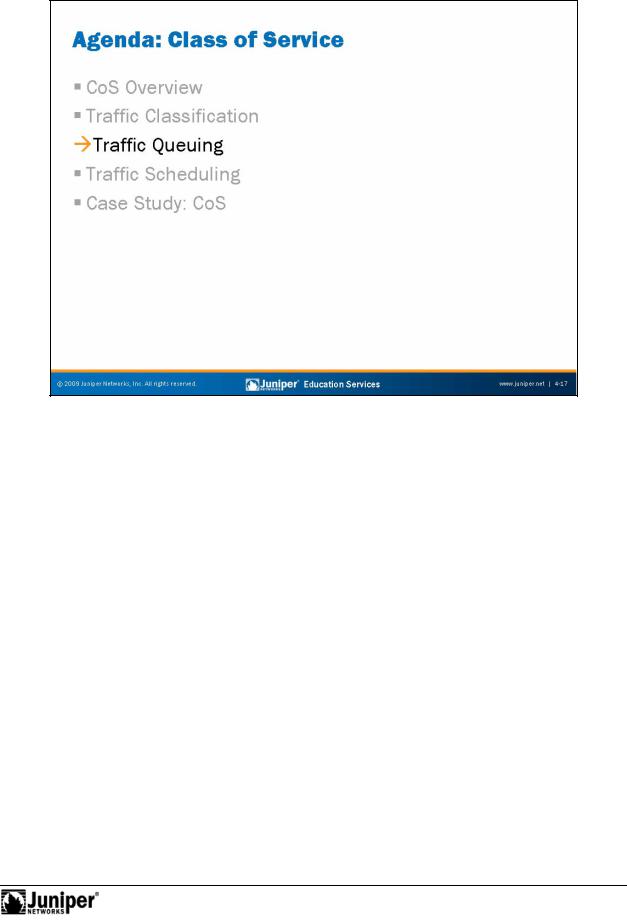
JUNOS Routing Essentials
|
|
Reproduction |
|
Traffic Queuing |
|
|
The slide highlights the topic we discuss next. |
|
Not |
for |
|
|
|
|
Class of Service • Chapter 4–17
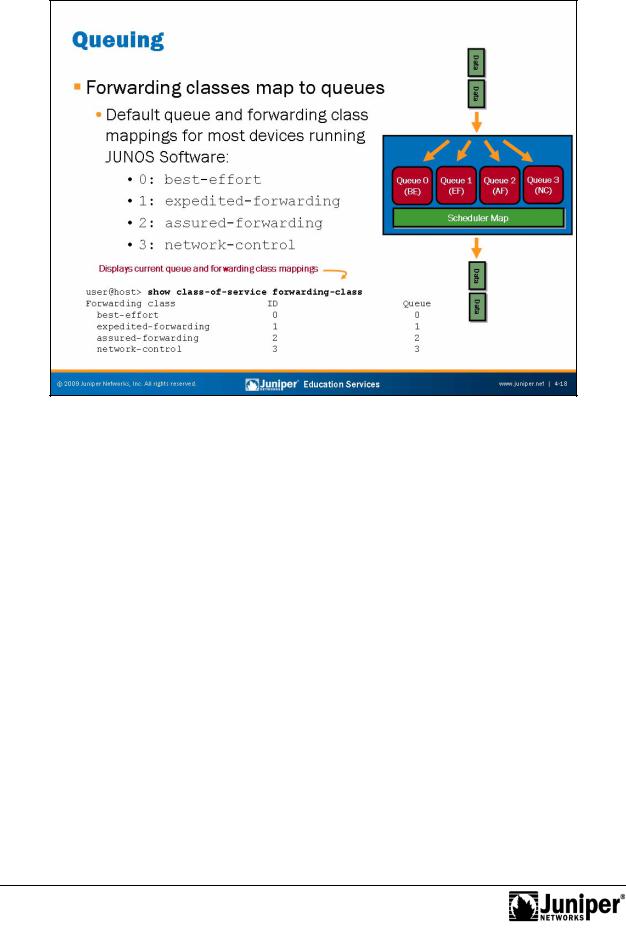
JUNOS Routing Essentials
Queuing Overview
When traffic reaches the outbound interface, the system places traffic associated
with eachforwading classReproductionin its own queue. The number of queues supported on outbound inte faces is hardware dependent.
Devices running JUNOS Software associate each forwarding class with a queue number. The slide shows the default forwarding classes for most platforms running
NotJUNOS So ware and their associated queue numbers. By default, JUNOS Software sends cer ain network control traffic (routing protocol messages, keepalives, and so f rth) to the queue associated with the network-control forwarding class (typically Queue 3), while all other traffic is sent to the queue associated with the best-effort forwarding class (typically Queue 0). You must configure some form of classifier to send traffic to any other queue.
After the system places traffic in the correct queues, a scheduler defines how the interface should process traffic from each queue.
Chapter 4–18 • Class of Service
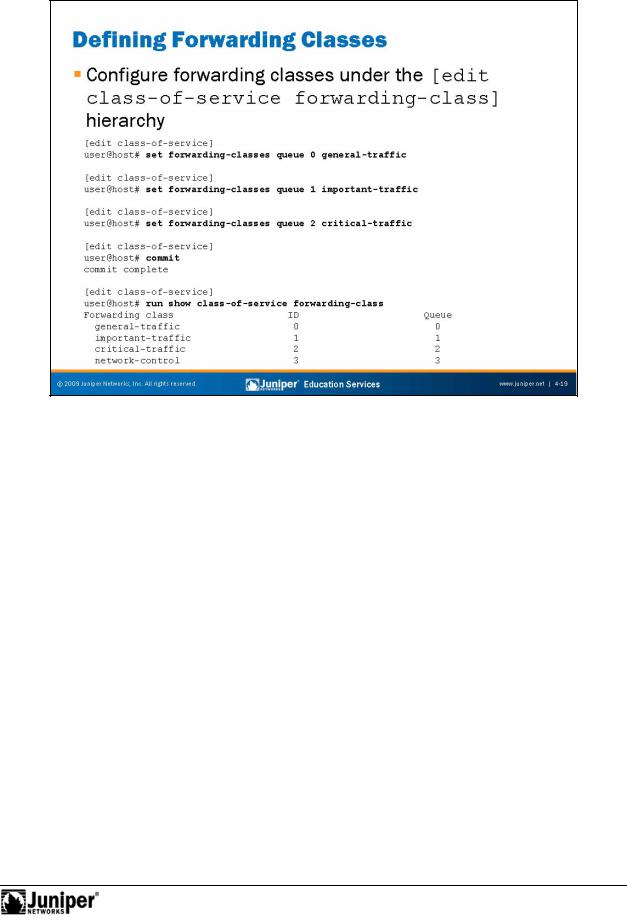
Not
JUNOS Routing Essentials
ForwardingReproductionClass D finition
You create forwarding classes by associating them with queues in the [edit
class-of-service forwarding-classes] hierarchy. If you attempt to define forwading classes for more queues than your hardware can support, the system displays an e or message when you attemp to commit the configuration. You must
ass ciate forwarding class name with a queue to use that queue. On most platforms running JUNOS Software the default forwarding class names are associated with Queues 0–3.
As the slide indicates, you can change the default forwarding class names. If you rename the default forwarding class names, the software still sends traffic to the corresponding queues. Additionally, the default BA classifiers and rewrite rules map traffic to and from the associated queues (again, typically Queues 0–3), regardless of the forwarding class names associated with those queues. In addition to changing the default forwarding class names, you can also assign forwarding class names to nondefault queues.
Forwarding classes are important because all other CoS rules reference forwarding classes, rather than queues. The software maintains the mapping between forwarding class names and queue numbers only in the forwarding class definitions in the [edit class-of-service forwarding-classes] hierarchy.
Class of Service • Chapter 4–19
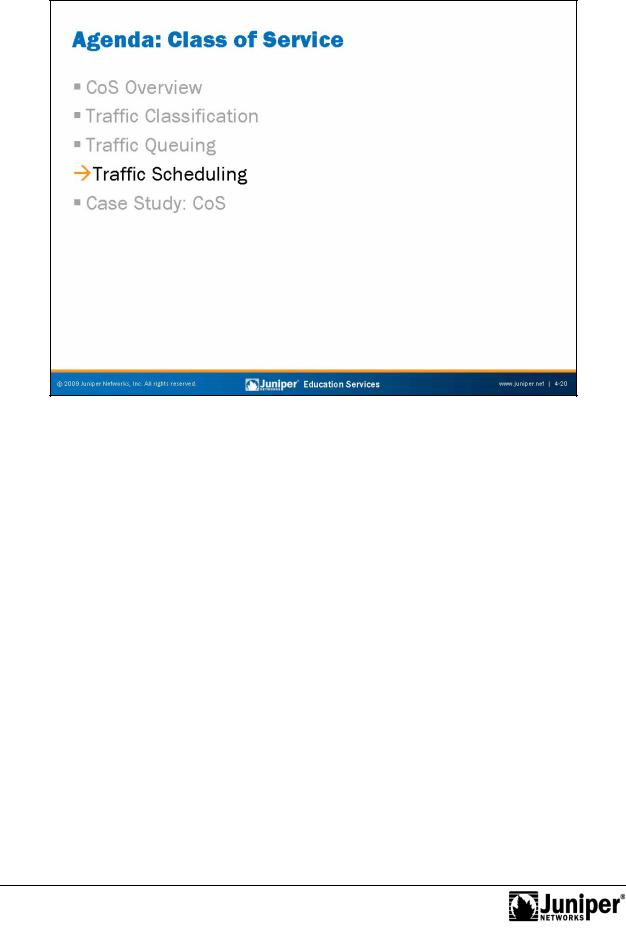
JUNOS Routing Essentials
Traffic Scheduling |
|
|
The slide highlights the topic we discuss next. |
||
|
for |
Reproduction |
Not |
|
|
|
|
|
Chapter 4–20 • Class of Service
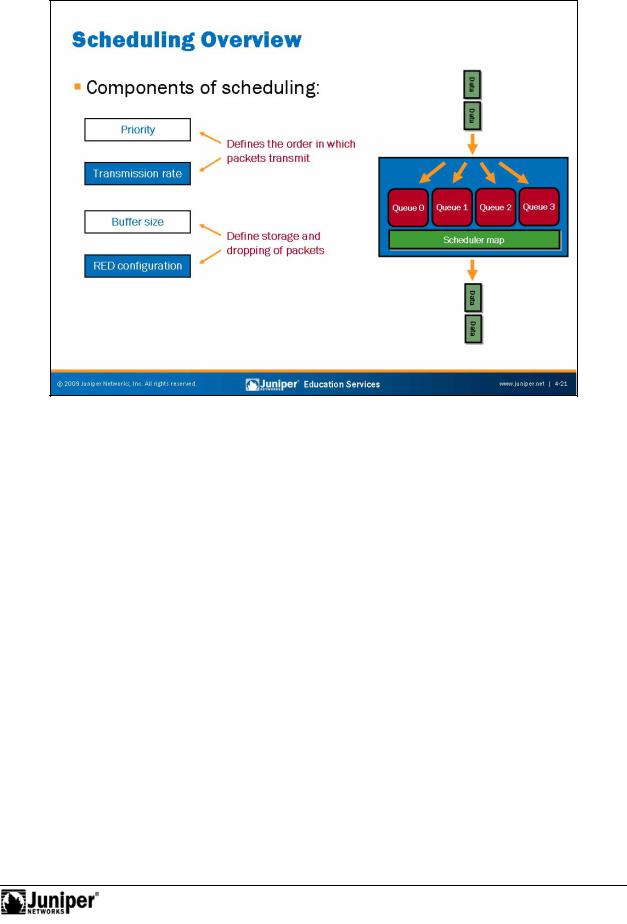
JUNOS Routing Essentials
SchedulingReproductionOv rvi w
You control the way the system services queues by configuring schedulers and forscheduler maps. A scheduler contains parameters that describe how to service a queue. A scheduler is associated with a particular queue and forwarding class thr ugh a scheduler map.
Y u de ine the order in which packets should transmit by defining a priority and a Notransmission rate for a forwarding class. Devices running JUNOS Software typically
ransmit packets from forwarding classes or queues with a higher-priority before those with a lower-priority. The default priority values might vary between JUNOS platforms.
You can configure a transmission rate for each forwarding class. The transmission rate controls how much bandwidth the traffic associated with a given forwarding class can consume. By default, the software assigns 95 percent of the bandwidth to the queue associated with the best-effort forwarding class (typically Queue 0) and
5 percent of the bandwidth to the queue associated with the network-control forwarding class (typically Queue 3). The software assigns all other queues a 0 transmission rate. By default, all queues can exceed their assigned transmission rate if other queues are not fully utilizing their assigned rates, unless you configure the transmission rate with the exact option.
Continued on next page.
Class of Service • Chapter 4–21

JUNOS Routing Essentials
Scheduling Overview (contd.)
The configured buffer size determines the size of each queue. By default, the software assigns 95 percent of the available buffer space to the queue associated with the best-effort forwarding class (typically Queue 0), and it assigns 5 percent of the available buffer space to the queue associated with the network-control forwarding class (typically Queue 3). By default, all other queues have 0 percent of the available buffer space; therefore, if you use queues other than those associated with the best-effort and network-control forwarding classes, you should assign buffers to those queues. As the buffer fills, the likelihood that the RED algorithm will drop packets increases. You can specify an exact RED drop profile for each queue; however, the default configuration is to not drop packets until the queue is full, and only then drop packets. Note all platforms running JUNOS Software do not support RED. Check your product-specific documentation for CoS support information.
|
for |
Reproduction |
Not |
|
|
|
|
Chapter 4–22 • Class of Service
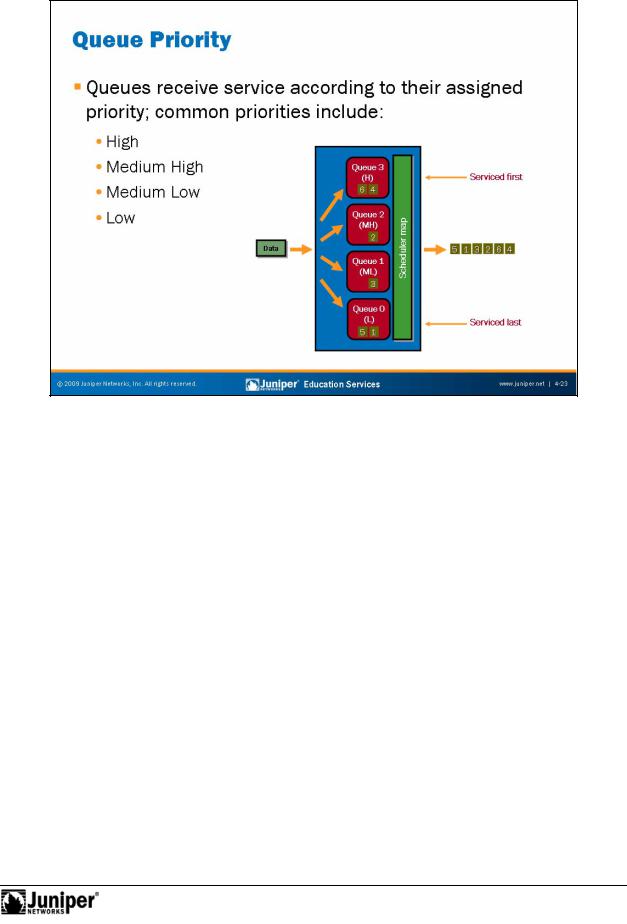
JUNOS Routing Essentials
Queue Priority
|
JUNOS Software supports multiple levels of transmission priority, which in order of |
|
increasing p iority are low, medium-low, medium-high, high, and strict-high. Using this |
|
priority st uctu allows JUNOS Software to service higher-priority queues before |
|
l wer-p i ity queues.ReproductionPriority scheduling determines the order in which an output |
|
inter ace transmits traffic from the queues, thus ensuring that queues containing |
Not |
imp rtant traffic receive better access to the outgoing interface. This procedure |
forinvolves the software examining the priority of the queue. In addition, the software |
|
de ermines if the individual queue is within its defined bandwidth profile.
Higher-priority queues transmit packets ahead of lower-priority queues as long as the higher-priority forwarding classes retain enough bandwidth credit. When you configure a higher-priority queue with a significant fraction of the transmission bandwidth, the queue might lock out (or starve) lower-priority traffic. Strict priority queuing works differently on different platforms. For platform-specific details and behavior, refer to the documentation for your specific product.
We provide a sample configuration showing a defined bandwidth profile on the next slide.
Class of Service • Chapter 4–23
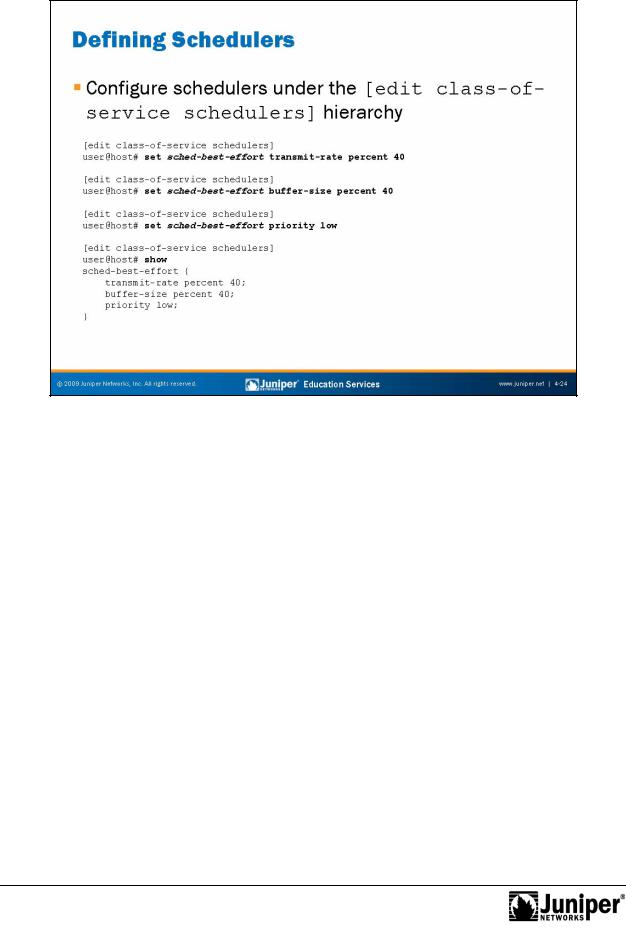
JUNOS Routing Essentials
Configuring SchedulReproductionrs
You configure schedulers under the [edit class-of-service schedulers] hierarchy. The name of the scheduler has no special significance. JUNOS Software associates schedule s with individual forwarding classes and queues using scheduler maps. In the example the slide, the software should use the scheduler for traffic in
the best-e |
rt rwarding class; therefore, we named it sched-best-effort to |
remind us |
its purpose; however, we could have named it anything and still |
associa ed it with the best-effort forwarding class in the scheduler map. |
|
for |
|
Not |
|
In this example, we configured the buffer size to be the same as the transmit rate. This practice should perform acceptably under many circumstances; however, cases exist where different buffer sizes are appropriate. You can find more details in the JUNOS Class of Service Configuration Guide.
Also, we did not configure a custom drop profile in this example. The default drop profile works well in many circumstances. Adjusting RED parameters by creating custom drop profiles can be quite complex. More details on that topic are also available in the JUNOS Class of Service Configuration Guide.
Chapter 4–24 • Class of Service
